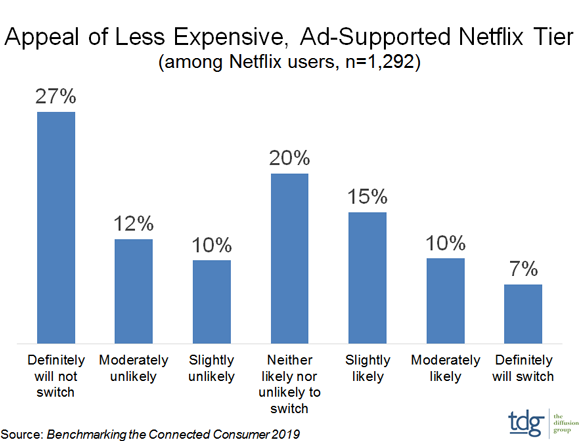Study: Nearly One-Third of Netflix Users Would Tolerate Ads
Nearly one-third of Netflix subscribers would consider switching to an ad-supported tier of the SVOD service if it were priced lower, according to a study by The Diffusion Group.
TDG surveyed 1,292 Netflix subscribers, part of a broader Benchmarking the Connected Consumer study, asking them if they would switch from their current Netflix service -- priced at about $15 per month -- for a lower priced version that also aired advertising. About 32% of respondents said they would likely or definitely switch, with 20% on the fence and about 49% saying they would definitely not or would likely not switch.

Netflix has been adamant about avoiding ads, while other streaming services like Hulu offer the option of an ad-free service for a higher price. But as content providers like The Walt Disney Co. and WarnerMedia continue to pull programming from the SVOD service to fuel their own direct-to-consumer offerings, prices for content rights could rise even higher, which could make advertising more attractive to help keep subscription costs down.
In its report, TDG said recent comments from NBC Universal and Hulu executives have rekindled ad-tier speculation.
“Given the rising costs of programming and growing debt, so goes the argument, it is just a matter of time before the company makes a move,” TDG said in its report.
Related: 23% of Subscribers Would Drop Netflix if it Had Ads
In the past year, Disney has canceled Marvel series on Netflix like Daredevil, Luke Cage and Jessica Jones and WarnerMedia is taking back Friends, one of the most-watched series on the SVOD service in 2020 for its own streaming service HBO Max. While Netflix may not want to offer an ad-supported tier, TDG president Michael Greeson wrote that it may not entirely be their choice.
Multichannel Newsletter
The smarter way to stay on top of the multichannel video marketplace. Sign up below.
"Netflix's response to its thinning third-party library is to spend more on originals, which it's gambling will keep subscribers from jumping ship,” Greeson wrote in the study. “But with half or more of its most-viewed shows being owned by three studios, each of which is launching their own DTC services, how long can you convince 55+ million US consumers that your service is worth paying a premium price, especially compared with Hulu (offers an ad-based option), Amazon Prime Video (free with Prime), and Disney+ (coming in a $6.99/month)?"
Given this context, and in order to offset mounting costs and pressure from investors to begin paying down debt, TDG believes Netflix will need to (1) increase the retail prices of subscriptions (which it recently did), or (2) create a new revenue stream, such as advertising.
"This should not be an either/or decision, but that's what it is," Greeson continued, citing TDG research from late 2018 that found Netflix's most recent price increase strained the limit of the service's value, even before popular third-party shows are pulled from the lineup.
TDG compared the Netflix situation to Blockbuster in the early 2000s. Blockbuster dominated the retail video rental business but as technology and customer habits changed, didn’t move with the times. While the Blockbuster analogy may be a bit of a stretch, TDG said if Netflix fails to evolve with the changing times, it could see its dominant position reverse.
That’s why Greeson believes Netflix will launch a less-expensive ad-supported tier, possibly in the next 18 months.
"Ads will become an important part of a comprehensive tiering strategy that helps bullet-proof Netflix for years to come," Greeson wrote.
